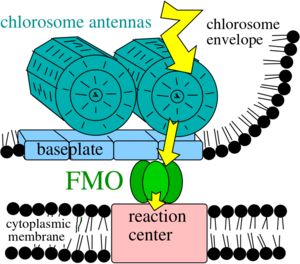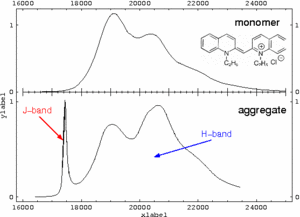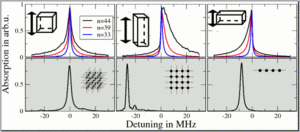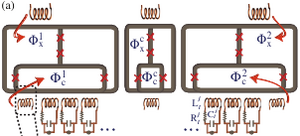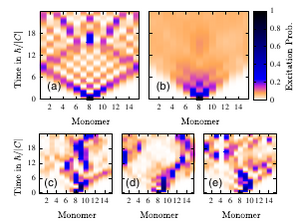
Research
Quantum aggregates are assemblies of monomers (molecules, atoms, quantum dots...), where the monomers largely keep their individuality. However, interactions between the monomers can lead to collective phenomena, like superradiance or efficient excitation transfer. We study different kinds of aggregates (e.g. light harvesting systems, arrays of Rydberg atoms, self-assembled organic dyes...) Using various methods (ranging from Green-operator methods over stochastic Schroedinger equations to semicalssical surface hopping) we study optical and excitation transport in these systems. Of particular interest is the coupling of the excitation to nuclear degrees of freedom.
Photosynthesis
The ability of photosynthetic plants, algae and bacteria to efficiently harvest sunlight has attracted researchers for decades and a fairly clear picture of photosynthesis has emerged: Sunlight is absorbed by assemblies of chromophores, e.g. chlorophylls. These assemblies, termed light harvesting complexes, transfer the excitation energy with high efficiency to so-called reaction centers, where the excitation energy is converted into a trans-membrane chemical potential.
Organic Dye Aggregates
Certain molecular aggregates consisting of organic dyes are remarkable in exhibiting an intense and very narrow absorption peak, known as a J-band, which is red-shifted away from the region of monomer absorption. Apart from those dyes showing the J-band on aggregation, there are also dyes where the absorption maximum is shifted to higher energies. The width of the resulting absorption band (called an H-band) is comparable to that of the monomeric dyes and shows a complicated vibrational structure.
Rydberg Aggregates
While in moleculare aggregates there is a strong coupling to vibrational degrees ultracold Rydberg atoms are ideally suited to study the above described phenomena in an clean and controllable environment.
In particular we have found that the coupling of electronic and nuclear degrees of freedoms allows to transport entanglement along a chain of atoms in effecive way. Furthermore we have investigate the effect of conical intersection in ultracold Rydberg gases on the excitation dynamics. We found that it is possible to directly observe the effect of Berry's phase.
Superconducting circuits
Open quantum system approaches are widely used in the description of physical, chemical and biological systems to describe the coupling of electronic degrees of freedom to vibrations. This structured vibrational environment makes simulations on a classical computer very demanding. We propose an analogue quantum simulator of complex open system dynamics which is based on superconducting circuits.
Stochastic Schrödinger equations
We have recently extended the non-Markovian Quantum State Diffusion approach to treat the energy transfer of coupled molecules. The picture shows Transport on a ring, when initially the excitation is localised on monomer 8. (a) No coupling to the environment. (b) coupling to a structured environment. This plot is an average of single trajectories (examples are shown in (c)-(e)).
Publications:
[1] A short description how to calculate absorption and energy transfer
